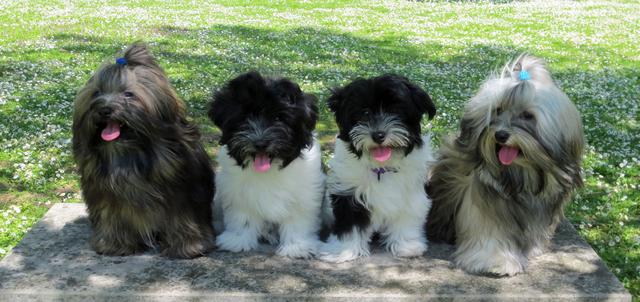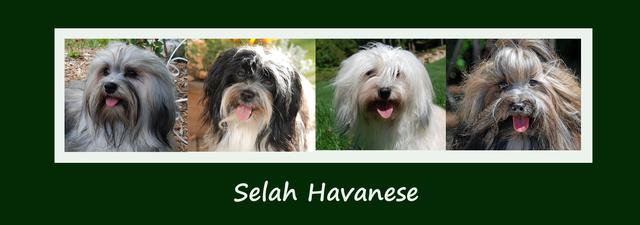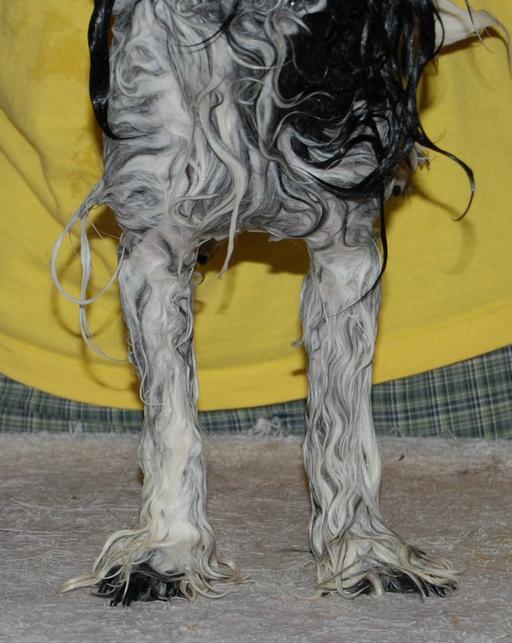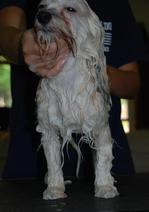What health tests should be done?
Besides being beautiful, hypoallergenic, small in size, easy to travel with, and prefect companions, it is important to health test all breeding dogs. Without testing, it is simply impossible to know if the dog is healthy. A vet check cannot determine most of these things, it requires a specialist, which often requires travel long distance, but it is well worth the effort because we want to produce as healthy puppies as possible.
Deafness - can be in one or both ears, all breeding dogs should have a BAER test to determine hearing. This must be done by a specialist. Dogs that are deaf in only one ear can function normally but should not be used for breeding because the risk is greater for producing deafness in both ears, which does create a special needs situation. All our breeding dogs have been tested and have normal hearing. We also test all of our puppies for hearing.
Cataracts - can cause blindness. CERF/EYE exams should be performed by a licensed Veterinary Ophthalmologist on all breeding dogs. Many breeders choose to give their dogs an egg yolk a day since cataracts have been linked to a lack of cholesterol. Think of it as an added nutrient, like vitamins, to help your dog's health. Dogs do not have issues with high cholesterol like humans do, they metabolize it differently. Although, egg yolks have also proven to be beneficial to human eye health as well. All our adult dogs have passed their CERF.
Hip Dysplasia - True hip dysplasia is the presence of abnormal changes in the hip joint combined with painful movement, otherwise known as degenerative joint disease (DJD) and osteoarthritis (OA). Joint laxity in the hip is a different thing. Joint laxity does not cause changes to the hip joint or cause pain to the dog. Joint looseness can be caused by hormones, sedation, or improper positioning during xrays which forces the joints apart. Even into old age xrays have verified that joint looseness does not equate to DJD, and dogs have long, healthy, active lives. There is not a verified problem in the breed with DJD or OA resulting in actual painful movement or limited mobility, but it is judicious to keep an eye on hips to keep it this way.
Hips have not proven to be a problem among Havanese, however, false OFA dysplastic hip scores have proven to be quite a problem in the breed, requiring many dogs to have additional xray evaluations (and more radiation) in order to get the normal hip score on the dog who has always had normal hips, or even worse, dogs who are put out of breeding programs due to a poor score, but the dog never truly had hip dysplasia to begin with, just a poor xray and poor reading, thus the gene pool becomes smaller and what that dog had to offer is no longer available to be contributed to the breed. There are some vets who specialize in having the correct OFA positioning, and they do get consistent OFA scores, however, most rural vets simply don't do enough of them to have the technique down to perfection, thus, many dogs are scored incorrectly due to less than perfect positioning. This is a problem there is not yet a good solution to.
When we screen hips, we only do it once, as we do not desire our dogs to have exposure to additional radiation. We do not sedate our dogs, thus the films are not 'perfect position' and scores can come up lower due to positioning. Our primary goal is to assure proper joint formation, which our vet can easily evaluate, even without OFA verification. OFA positioning has become a very touchy subject among hip evaluations, thus, the reliability and effectiveness of these screenings does come into subjection. A dog should not come back dysplastic with one xray and excellent with another. A dog cannot be both at the same time. Obviously the dog had excellent hips the entire time.
We feel it is important to evaluate for correct joint formation, but do agree a good vet can do this and that OFA evaluations have proven to be less than consistent.
Current research shows that the genetic link to hips is about 15-30% with the rest being environmental development leading to true hip dysplasia. Thus, if they are able to find the genetic link to hip dysplasia, we will truly be able to test for it, for now, we can discern if the parents have normal hip formation, but we cannot determine if they carry for hip dysplasia. It has been proven, dogs with good hips can produce dogs with bad hips and dogs with bad hips can produce dogs with good hips, this is because of the environmental factor. Walking surface, how much activity, the condition/weight a dog is kept at, the age of spay/neuter, etc. all have a great affect on hip joint development (as well as other joints). Thankfully, in the Havanese degenerative joint disease is uncommon.
Hopefully they will find the genetic markers so breeders can test at a genetic level, thus ruling out all environmental influences and also ruling out all marginal screening techniques. For now, all of our dogs have had hip xray and screening by our vet. If we are able to get the correct OFA position those screenings are sent to OFA. We will not over radiate our dogs in order to get the exact positioning. We trust our vet to read and determine if our dogs have proper hips acceptable for breeding. Sadly we live very far from any vet who does hip evaluations with any consistency to get proper positioning. We have discussed this extensively with our Vet and have developed a plan for our dogs to assure their health and suitability for breeding and avoid the over radiating, which is not in their best interests.
Patella Luxation - slipping of the knee cap. Can be congenital (existing from birth) or acquired. Can be caused by over use or injury and be mild or severe. All our dogs have passed patella exams and all our puppies are screened for patellas also. We have yearly patella exams on our dogs to assure they remain stable as they age. While OFA patella exams are a one time exam, in my opinion patella's should be checked regularly as part of the ongoing screening of all breeding dogs.
Cardiac - abnormal heart function. All our dogs have been checked for normal cardiac function. All our puppies are also screened for normal cardiac function. We do yearly cardiac exams on our dogs to assure they maintain healthy heart function as they age. While cardiac testing is not listed as part of the Havanese required testing, in my opinion it is absolutely necessary as part of the ongoing health screening of breeding dogs.
Liver and Kidney - all our breeding dogs have normal blood panels screening for liver and kidney function. Liver and kidney panels are done on our dogs at least every three years to assure they maintain proper function. While liver and kidney panels are not listed as part of the Havanese required testing, and are not listed on OFA, in my opinion they are absolutely necessary as part of the ongoing health screening of breeding dogs.
Chondrodysplasia or 'CD' - the bowing of the front leg which can occur in one or both legs caused by the premature and/or uneven closure of the growth plates. It has also recently been found that over feeding a puppy can cause the bones to grow faster than the soft tissue and cause bowing of the legs, which would results in a structural flaw caused by nutritional issues. At best, bowed legs is a conformational fault found in the Havanese. At worst, it 'may' be associated with other serious health concerns. There are many dog breeds which describe a chondrodysplastic dog, such as the Corgi. The Havanese does NOT describe a chondrodysplastic dog. By breeding away from CD breeders are breeding toward conformational correctness. All of our dogs have lovely straight legs and we breed to this standard. The Havanese is NOT a short legged (dwarf) or CD breed, rather it is a small, balanced dog with straight legs. The Havanese also does NOT have shorter front legs than rear legs. This is a misconception. According to the AKC standard the Havanese has a short upper arm, which is different from short front legs. The upper arm is the bone that connects the scapula to the elbow/lower arm (front leg). This is a very important distinction and makes a huge amount of difference in the structure and soundness of the dog.
What are soaps?
Soaps or soaped photos are pictures taken of the dog while they are wet and soapy so you can see what the structure of the dog is under all that beautiful hair. It allows the breeder to evaluate the structure, proportions, and angles of the dog. If there are any structural deviations these can be seen in soaped photos. You should see nice straight legs in the parents photos.
Please shop carefully!
While looking at an adorable little puppy it is almost impossible to think with a clear mind. They are all just so sweet. They are cute and cuddly and that sweet puppy breath! Do your homework first. Study and learn about the breed and interview various breeders. Make certain all health tests are done. While all the details can be overwhelming, the more knowledgeable you are the better prepared you will be to bring home your perfect little pup. A little time investigating now could prevent a lot of suffering and expense later. Make sure you are comfortable with the breeder and they are knowledgeable about the breed standard and health concerns.
WARNING: No matter which breed you choose, if a breeder says health testing is not important, does not register their test results with OFA, says there are not problems in their lines, says it is too expensive and unnecessary, or gives any other excuse for not health testing....RUN AWAY and find another breeder. There is simply no excuse for not health testing, it is for the betterment of the breed and is for the protection of your future puppy. Accept nothing less!
Health Info
Our goal is to produce happy, healthy puppies for wonderful families to enjoy. We take seriously every little life we help bring into this world and are committed to each puppy for their lifetime. While there are no guarantees in nature, we believe in doing what we can to preserve the health of the breed. We feel health testing is essential, however, it is just the beginning of the necessities in breeding. Careful consideration of correct structure, genetic diversity, and overall basic health are each critically important. Things such as skin disorders, ear infections and weepy eyes are just as important to us as items which can have OFA testing for. For us, we will not breed a dog that has allergies, chronic ear infections, hot spots, etc. These things are just not fun for the owner or the dogs and while they may not get OFA status, they are critical to the health of the dog and breeding dogs with these things will only perpetuate it on the breed. Thus, all aspects of the dog must be considered to determine what they have to offer the next generation, both positive and negative must be considered and very careful selection must be made to assure the puppies will be getting the very best start in life.
The thing to remember with health testing is that it is just the beginning. It is essential to have healthy parents to give the puppies the very best start in life. However, what happens after the puppy leaves the house is also critical to the puppies development. Current research has shown that providing too much calcium, phosphorus or protein to a puppy can cause skeletal and/or soft tissue disorders as the puppy may grow too quickly. Research has also shown that disorders such as hip dysplasia, once thought to be genetic, now has a very high correlation to both nutrition and activity/environment. Thus, as we learn more genetically, we are learning that more things we 'thought' were purely genetic are more and more influenced by environment also to a large degree. This is true for all growing joints and ligaments, too much nutrition, too much exercise etc can cause growth issues and damage to growing bones and joints. A fat puppy is not a healthy puppy, they may be adorable, but a puppy should be kept in good condition just like an adult. Obese puppies can also suffer from joint issues later in life. Joint issues have also been linked to puppies doing stairs before a year old... there is just so much we don't yet know about all the potential health issues, however, assuring the parents are healthy is the first and most important step we can take in giving puppies the very best start in life.
So, give your puppy the very best start by assuring the parents have been health tested, then, provide them will correct nutrition and regulated activity as they are growing and maturing, as well as appropriate socialization. The more we learn genetically, the more we are also learning how much environment plays a very important part in the development of your puppy, not only in temperament, but also in health.
We would be glad to answer any questions you may have about Havanese or health testing.
Genetic Diversity
As lovers and breeders of the Havanese, and keepers of the breed, we feel it is our responsibility to do all possible to assure the future health of the breed. Genetic diversity has been proven to increase the health of populations, regardless of species. We have chosen for years to reject the idea of the ever popular line/inbreeding in the attempt to make 'cookie cutter' puppies. Instead, we have determined to research pedigrees and outcross, looking for pedigrees with little or no crossover. We have evaluated pedigrees, health testing, and selected for dogs of good breed type and correct structure that are compatible with each other in order to produce puppies who look and act like a Havanese should, and also have a low inbreeding coefficient.
We are very excited that thanks to UC Davis, we can now run DNA diversity panels on all of our dogs to evaluate each dog, and each potential breeding, at the genetic level to help assure greater genetic diversity. Genetic diversity has been linked to healthier immune systems and overall greater health. Not only can we use Coefficient of Inbreeding (COI) based on pedigree, we can use DNA analysis to look at homozygosity level on a genetic level, which opens the door for potential breedings which we may have previously passed on, but now being able to evaluate DNA, we are able to see genetically how closely related a pair may be. Thus, it is possible to do a line breeding with the assurance of knowing the puppies will maintain genetic diversity. What a wonderful tool for breeders to have access to.
What DNA diversity testing does NOT tell you: this test unfortunately does not, at this time, provide any DNA markers for specific genetic disorders. It simply shows the level of diversity of each individual parent as well as what the potential diversity will be in a given breeding. This allows for breeders to check for genetic compatibility to assure no breeding will become overly homozygous (having two copies of the same allele), which is not ideal. Keeping diversity in the breed is good for each puppy and also for the breed as a whole.
In an ideal world, we would have genetic markers for serious health factors so we could test for these diseases on a DNA level. This would allow us to identify the carriers of the disease and do selective breedings with non-carries and thus we could avoid the disease and keep the maximum number of dogs in the gene pool to allow for the greatest diversity. However, at this time the Havanese do not have any DNA markers for genetic disease. We do have markers for 'satin' or 'short' coat, which is the improper spaniel coat, thus we are able to test and avoid this incorrect coat type. We can also test for curly coat to avoid the poodle coat. We can test for 'd' dilute, which if a dog inherits two copies 'dd' of the dilute gene, they can also develop color dilute alopecia, which makes the dogs hair fall out similar to a dog with Salacious Adonitis.
While there are many things that cannot be tested for, we are doing all we can to help assure the Havanese maintain genetic diversity, overall health, breed type and exceptional character through each generation. We love the breed, and of course our precious pups, and only want the very best for them and hope to provide the highest opportunity to each puppy with careful selection. Of course, there are no guarantees when you are dealing with complex living beings, however, we do our best to cover as many bases as possible, and starting with healthy, strong, well balanced parents.
We also believe in providing an optimal environment during pregnancy and after the puppies are born to facilitate well balanced, happy, well socialized puppies.
Early Neurological Stimulation and Training
In addition to health testing and genetic diversity testing, we also provide our puppies with Early Neurological Stimulation (ENS), and a training protocol used by Puppy Culture to help assure the puppies have the correct stimulation opportunities to help the puppies develop into well rounded puppies and provide them with an optimal start in life. Research has clearly shown puppy development and health is partially genetic and partially environmental and experiential, therefore, we will go to all extremes to provide the very best for our puppies.
The ENS protocol is simply a reminder for breeders to interact with their newborn puppies rather than wait for them to be up and moving around. There is nothing 'magical' about the protocol, it's simply a way of stimulating early development of the brain. These protocols may be followed, or substituted for other stimulating activities such as snuggling, weighing puppies, wiping puppies up if they get a bit sticky, etc. The important thing is to assure the puppies are handled each day by humans and that they have that interacting and learn to develop associations with humans from an early age. This is a process similar to imprinting on a newborn horse, but in puppy terms.
Our puppies are loved, snuggled and weighed daily to assure the very best development.




